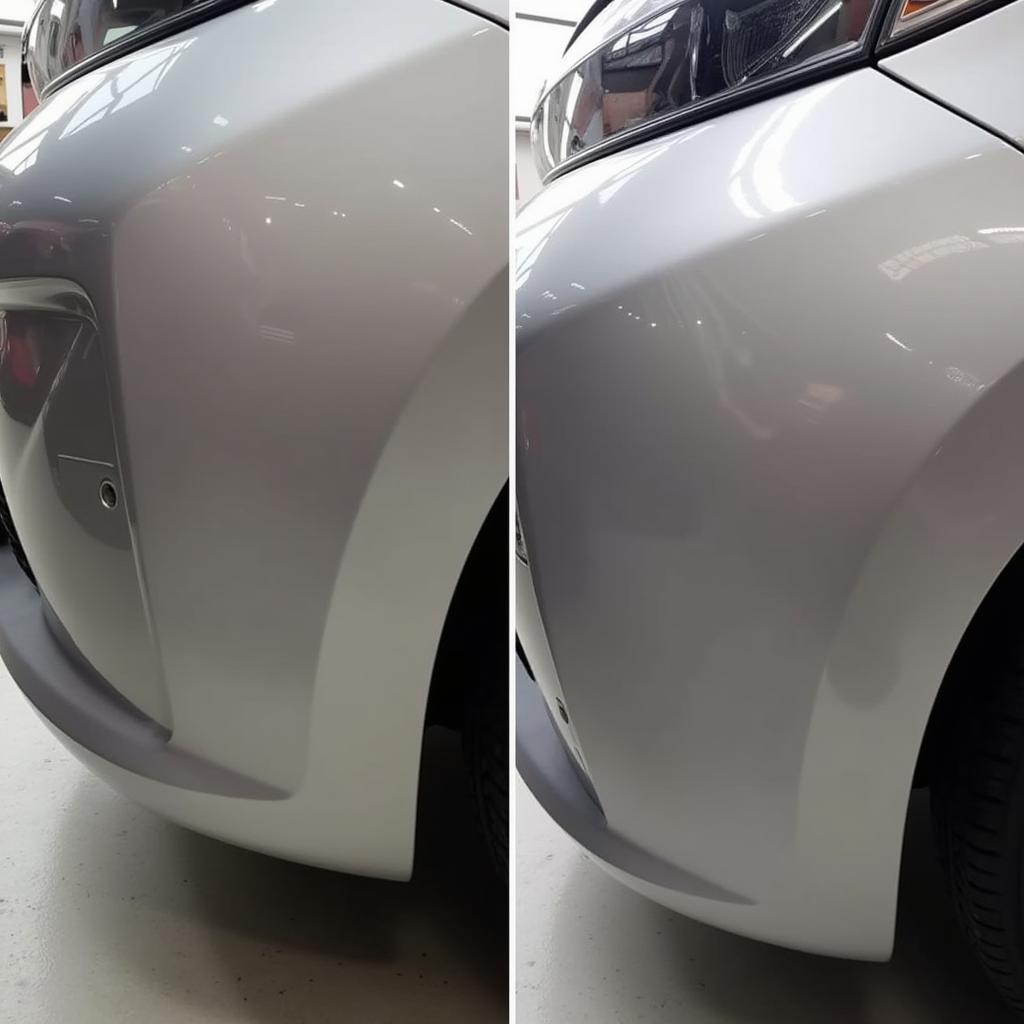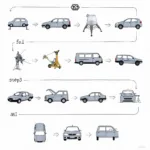Repairing car bumper paint can seem daunting, but with the right knowledge and a little patience, you can achieve professional-looking results and save yourself a significant amount of money. This guide provides a comprehensive step-by-step approach to fixing those unsightly scratches, chips, and cracks on your car bumper, restoring its original shine. We’ll cover everything from assessing the damage to applying the final clear coat. Let’s dive in and learn how to repair car bumper paint like a pro.
how to repair paint scratches on car bumper
Assessing the Damage: Know Your Enemy
Before you start gathering your supplies, it’s crucial to assess the extent of the damage. A minor scratch will require a different approach than a deep gouge that exposes the bare bumper. Carefully examine the affected area. Is it a surface scratch, a chip that’s penetrated the color coat, or a crack that runs deep? Identifying the type of damage will determine the best repair method and the necessary materials. For example, a light scratch might only require a rubbing compound, while a deep chip will need primer and touch-up paint.
Gathering Your Supplies: The Right Tools for the Job
Having the right tools and materials will make the car bumper paint repair process much smoother. You’ll need items like sandpaper (various grits), masking tape, primer, touch-up paint (matched to your car’s color), clear coat, rubbing compound, polishing compound, and microfiber cloths. Don’t forget safety equipment like gloves and eye protection. Using quality products will ensure a durable and long-lasting repair.
Preparing the Surface: A Clean Slate for Success
Proper surface preparation is key to a successful car bumper paint repair. Thoroughly clean the damaged area with soap and water, then rinse and dry completely. Use masking tape to protect the surrounding areas from overspray and sanding. For deeper scratches or chips, you’ll need to sand the area with progressively finer grits of sandpaper, starting with a coarser grit (e.g., 320) and working your way up to a finer grit (e.g., 2000). This creates a smooth surface for the primer and paint to adhere to.
Applying Primer and Paint: Building the Foundation
If the damage has penetrated the color coat, applying primer is essential. Primer provides a base for the touch-up paint and helps prevent rust. Apply thin, even coats of primer, allowing each coat to dry completely before applying the next. Once the primer is dry, apply the touch-up paint, again using thin coats to prevent runs or drips. Patience is key here, as rushing the process can lead to imperfections.
Applying Clear Coat and Finishing Touches: The Final Polish
After the touch-up paint has dried completely, apply a few coats of clear coat to protect the paint and restore the bumper’s shine. Once the clear coat is dry, use rubbing compound and polishing compound to blend the repaired area with the surrounding paint. This step is crucial for achieving a seamless and professional-looking finish. Finally, wipe the area clean with a microfiber cloth to reveal the gleaming, repaired bumper.
how much is a car bumper repair paint
How do I match the touch-up paint to my car’s color?
The best way to match touch-up paint is to use the color code found on your car’s information sticker, usually located inside the driver’s side doorjamb or glove compartment. Automotive paint suppliers can use this code to mix the exact color for your car.
Can I repair a cracked bumper myself?
While minor cracks can sometimes be repaired using epoxy or plastic welding techniques, larger or more complex cracks are best left to professionals.
What if the damage is to a plastic bumper cover?
The process for repairing paint on a plastic bumper cover is similar to that of a metal bumper, but you might need a specialized plastic primer for better adhesion.
how to repair cracked paint on car bumper
 Finished Car Bumper Paint Repair
Finished Car Bumper Paint Repair
Conclusion: A Restored Bumper and a Sense of Accomplishment
Repairing car bumper paint yourself not only saves you money but also provides a sense of accomplishment. By following these steps, you can tackle those minor blemishes and restore your car’s appearance. Remember, patience and attention to detail are key to a successful how to repair car bumper paint project.
FAQs
- How long does it take for the paint to dry completely? Drying times vary depending on temperature and humidity, but generally, allow at least 24 hours for the paint to cure fully.
- What should I do if the paint runs or drips? If the paint runs, let it dry completely and then sand the area smooth before applying another coat.
- Can I use spray paint for touch-ups? Yes, you can use spray paint, but ensure it’s specifically designed for automotive use and matches your car’s color code.
- How can I prevent future bumper damage? Be mindful of parking curbs and avoid bumping into objects. Applying a paint protection film can also help prevent scratches and chips.
- What if the damage is more extensive than just paint scratches? For significant damage, consult a professional auto body repair shop.
- Can I use a hairdryer to speed up the drying process? While a hairdryer can help, be careful not to overheat the paint, which could cause it to blister.
- What type of clear coat should I use? Use an automotive-grade clear coat designed for compatibility with your touch-up paint.
how to repair chipped paint on car bumper
For further information on car paint repair costs, please visit how much is a car bumper repair paint. You might also find our guide on repairing scratches helpful: how to repair paint scratches on car bumper.
Need assistance with your car repair? Contact us via WhatsApp: +1(641)206-8880 or Email: [email protected]. Our customer service team is available 24/7.


